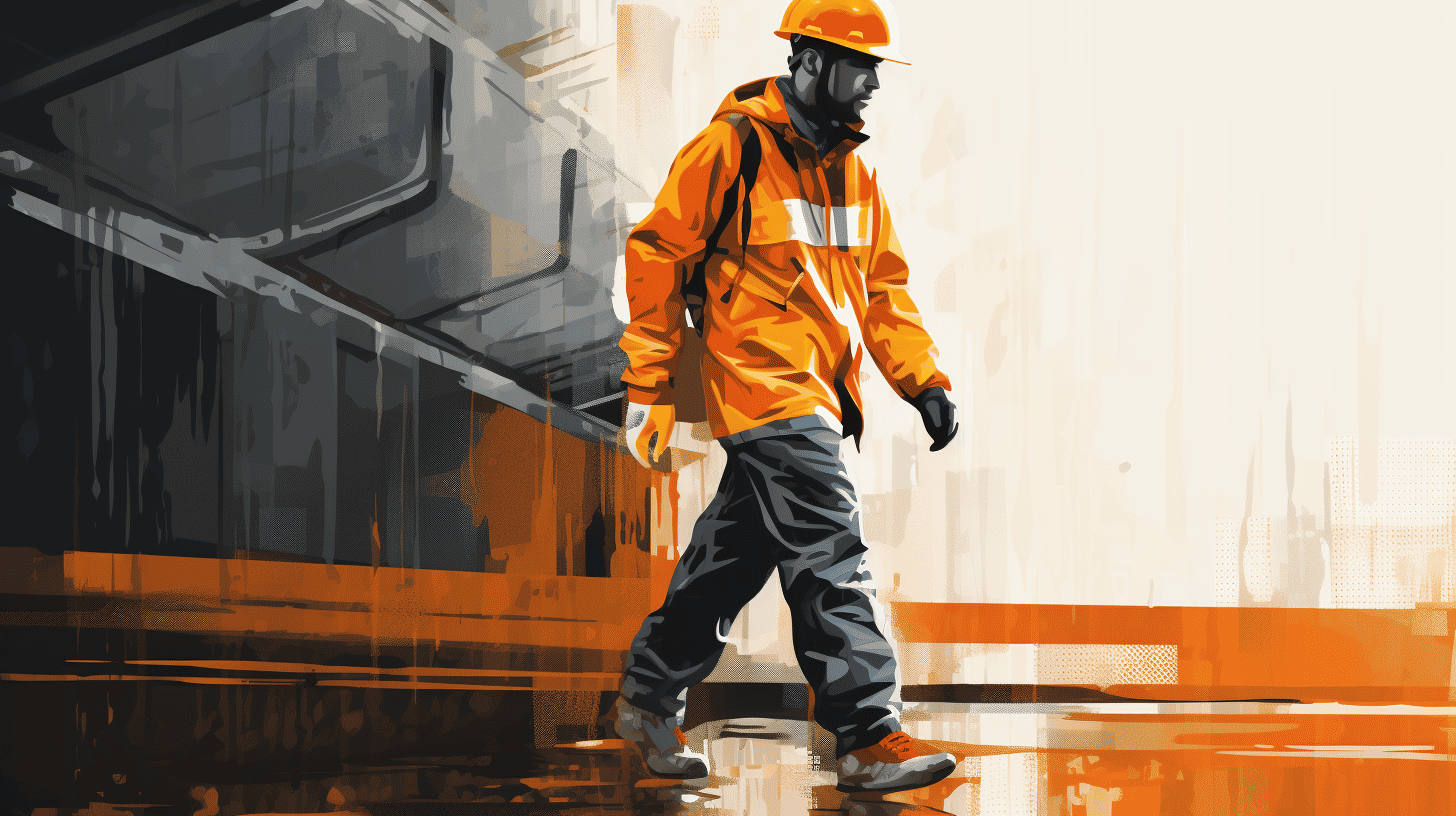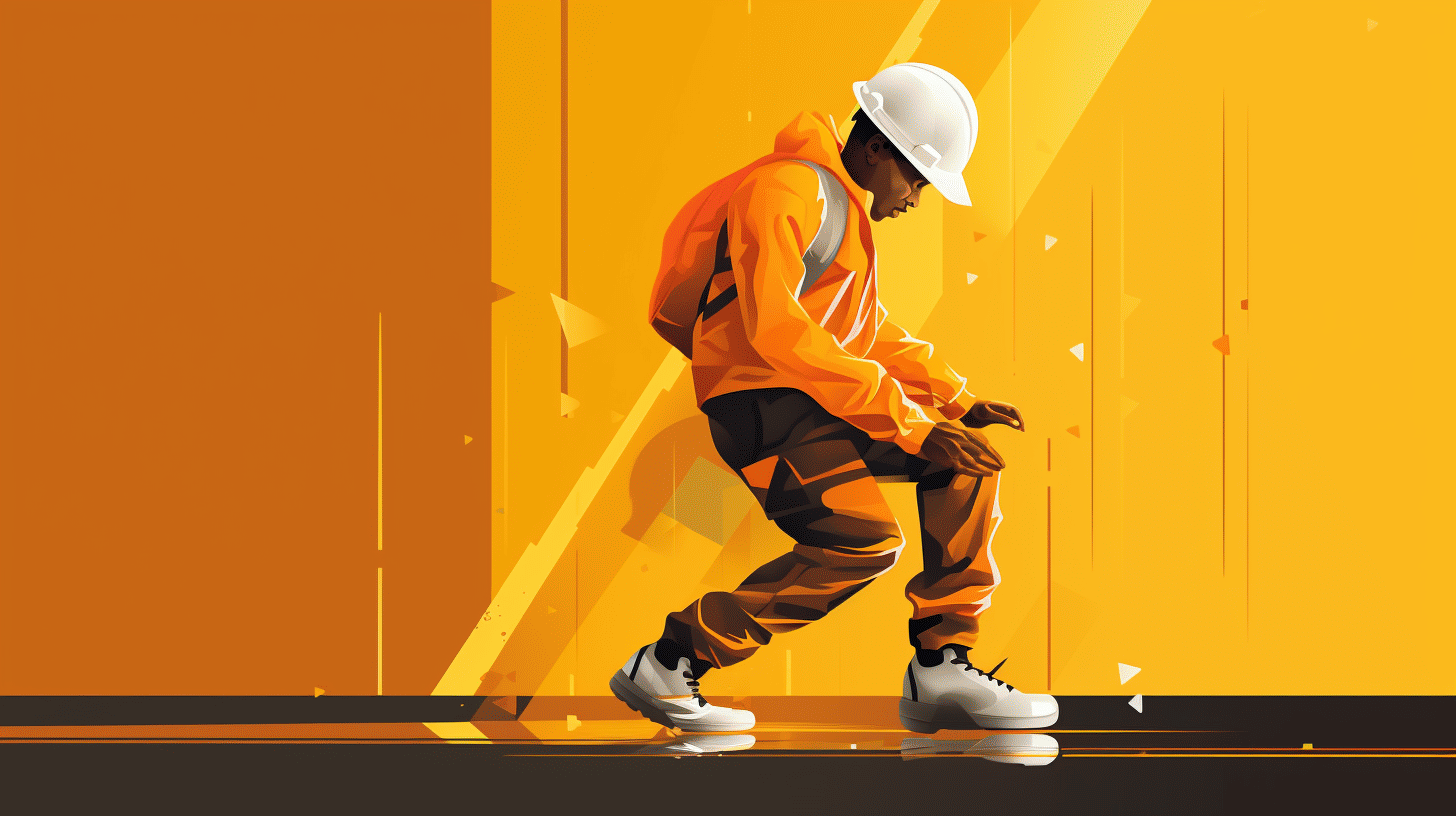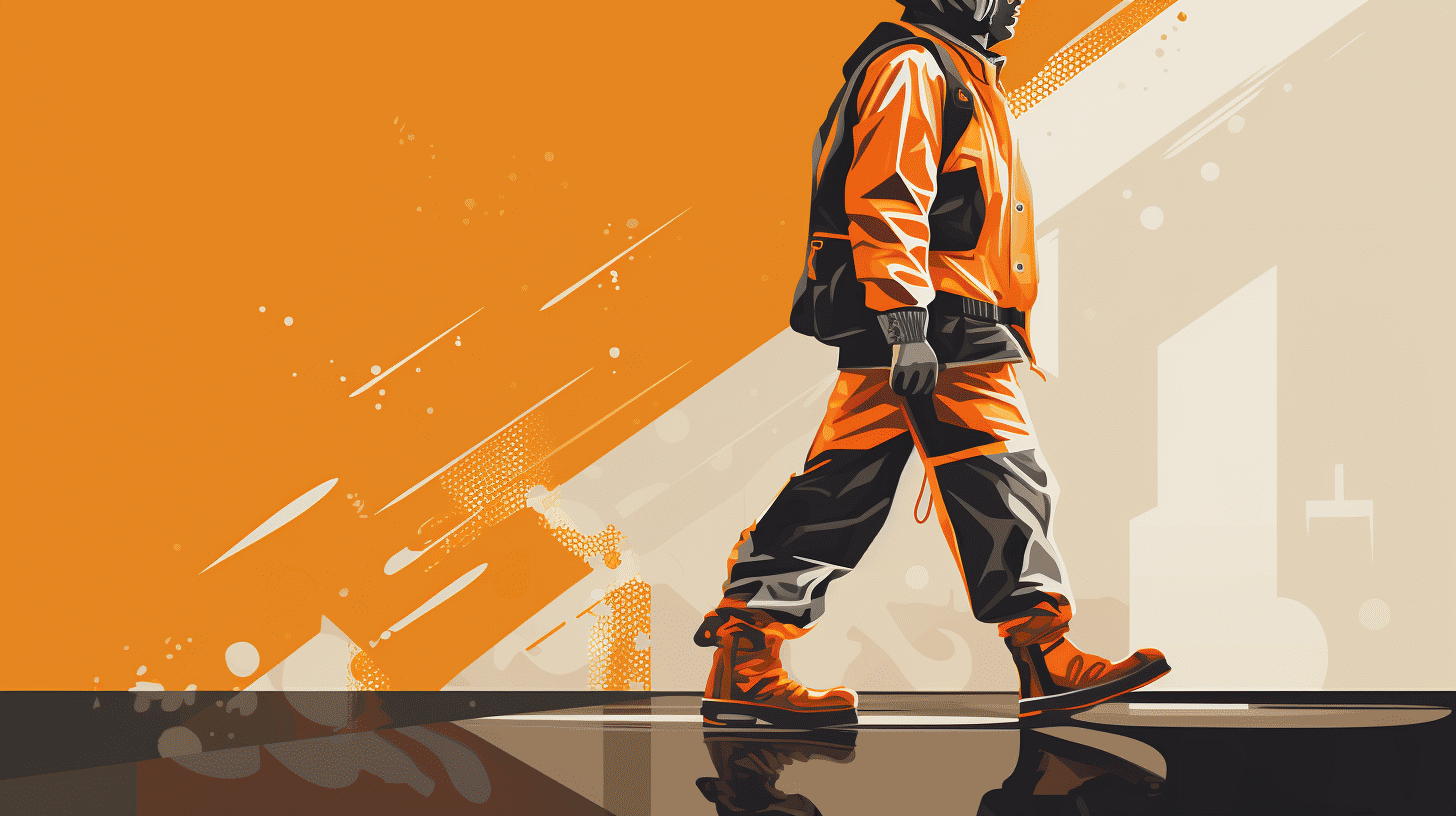As the saying goes, "there's no such thing as bad weather, only bad clothes." This couldn't be more accurate for those in the construction industry. Work doesn't stop for a little bit of rain, but without the right gear, productivity and safety can be significantly compromised. Understanding the essentials of rain gear can make all the difference in a construction worker's ability to perform, stay safe, and remain comfortable on the job. In this article, we'll explore the importance of rain gear for construction work, identify the different types of essentials you'll need, evaluate the materials commonly used, and offer tips for choosing the best gear. In addition, we'll discuss how to maintain this gear properly, ensuring it continues to serve you well in all weather conditions. Let's dive in and start exploring the importance of rain gear in construction work!
Importance of Rain Gear in Construction Work
Working in the construction industry is demanding, and the situation often gets challenging when dealing with unpredictable weather conditions. Amongst those, rainfall brings an array of obstacles, affecting the workers' safety, productivity, and health if not adequately equipped. Therefore, investing in quality rain gear for construction work is not just a necessity, but a precautionary measure to achieve optimal performance and maintain well-being.
Safety Measures
It's already known that construction sites are riddled with potential hazards. When rain adds to the mix, the risks increase exponentially due to slippery surfaces and reduced visibility. Here, high-quality rain gear comes to the rescue, providing the following advantages:
- Accident Prevention: Comprehensive rain gear is designed to enhance the grip, reducing the chances of slips and falls.
- Improved Visibility: Rain gear usually comes in bright, reflective colors, allowing coworkers to spot each other easily in the reduced light during rainfall.
- Equipment Protection: Waterproof coverings can also shield essential tools from getting damaged due to excessive moisture.
Productivity Improvement
Apart from safety, rain gear also contributes to a construction worker's productivity. Wondering how? Let's dive into some key points:
- Flexibility to Work: Rain is no more an excuse to stop the work if the worker is equipped with proper rain gear. It provides the flexibility to continue the task without worrying about getting drenched.
- Comfort: Soggy clothes can be uncomfortable, leading to lower work efficiency. Rain gear keeps the worker dry, providing comfort and thus, promoting better productivity.
Health Precautions
Last but certainly not least important fact is that wearing the right rain gear can shield workers from potential health risks:
- Hypothermia Prevention: Exposure to cold rain can lead to hypothermia. However, good-quality rain gear keeps the body dry, maintaining the body temperature and preventing such health complications.
- Disease Protection: Rain often carries pathogens leading to various diseases. Wearing rain gear can act as a preventive layer against these harmful pathogenic intruders.
In a nutshell, equipping construction workers with adequate rain gear is imperative. It enhances safety measures, boosts productivity, and safeguards against potential health risks. Without a doubt, rain gear plays an integral role in ensuring the overall safety and productivity of construction work, come rain or shine.
Types of Rain Gear Essentials for Construction Work
Rain or shine, construction work doesn't stop. While weather can be unpredictable, it's important for construction crew members to be prepared for whatever Mother Nature throws their way. This often means investing in high-quality rain gear that not only offers protection but also promotes comfort and productivity. From sturdy jackets to tough boots, we've compiled a list of essential rain gear for construction work.
Waterproof Jackets
When it comes to heavy downpour or a light drizzle, waterproof jackets are a construction worker's first line of defense. They provide comprehensive protection from rain, keeping the wearer dry and comfortable. But, it's not just about being waterproof. Look for jackets with features like:
- Breathability to prevent sweating
- High-visibility colors for safety in low light
- Sturdy materials for durability and protection from the elements
- Adjustable cuffs and hoods for a secure fit
Rain Pants
Coupled with a waterproof jacket, rain pants form a complete protective ensemble. They safeguard the lower body, preventing water from seeping into your clothes. Remember to check for features such as:
- Seamless construction for maximum waterproofing
- Elastic or drawstring waistbands for comfort and adjustability
- Reinforced knees for durability
- Ventilation features for breathability
Water-resistant Boots
Footwear is fundamental in construction work, more so in wet conditions. Water-resistant boots ensure your feet stay dry and, as a bonus, they're usually built with materials resistant to punctures or slips, ensuring a safer work environment. Consider boots with:
- Non-slip soles for prevent accidents
- Insulation for warmth in cold weather
- Comfortable insoles for long work hours
Non-slip Gloves
Proper grip is crucial in construction work, particularly in rainy conditions. Non-slip gloves ensure firm grip while also protecting hands from wetness. Look for gloves featuring:
- Waterproofing materials
- Good insulation and comfort
- Sturdy grip, especially on the palms
Hard Hat Rain Cover
A hard hat rain cover is a less known but just as crucial piece of rain gear. It keeps the head dry and ensures the rain does not trickle down onto your face or neck, causing discomfort. Find covers with:
- Clear plastic front for visibility
- Secure fit to the hard hat
- Lightweight and compact for easy carrying and storage
Waterproof Tool Bags
Lastly, don't forget about protecting your tools. Waterproof tool bags keep your gear safe, organized, and accessible even in heavy rain. Key features to look for include:
- Robust waterproof material
- Multiple compartments for organization
- Sewn, not glued, seams for better water-resistance
Rain or not, construction work must go on. However, with the right rain gear, weather woes can be mitigated, paving the way for more productive and safer working days. Once you've got your essentials covered, don't forget to check on their condition regularly and replace as necessary for optimal protection.
Materials Used in Rain Gear
When you're facing the fury of a downpour, your best defense is a good rain jacket. But, have you ever wondered what your rain gear is made from? What materials keep you dry amidst furious rainfall? The answer lies in science and smart engineering that leverage the waterproof properties of certain materials. Yes, there's more to rain gear than just saying it's "water repellant." Let's dive into understanding three of the most popular materials used in rain gear: Polyvinyl Chloride (PVC), Polyurethane (PU), and Nylon with a waterproof coating.
Polyvinyl Chloride (PVC)
Arguably one of the most recognized materials, PVC, forms the cornerstone of traditional raincoats. Known for its durable and waterproof properties, PVC comes from synthetic plastic polymers, which contribute to its infamous flexibility and resilience.
- Durability: PVC raincoats are renowned for withstanding harsh weather conditions. They don't tear easily, ensuring a massive lifespan for your trusted rain gear.
- Waterproof: The non-porous nature of PVC rain gear makes it a complete barrier against water. In other words, it keeps you entirely dry during the heaviest downpours.
- Ease of Maintenance: Cleaning a PVC raincoat is as simple as running a damp cloth over it. Its smooth surface doesn't trap dirt, making it impressively simple to maintain.
Polyurethane (PU)
Modern rain gear has increasingly adopted the use of Polyurethane, or PU for short. This waterproof material offers a lighter and more breathable alternative to PVC.
- Lightweight: Technological advances in the production of PU have resulted in a material that is much lighter than PVC, making PU rain gear easier to carry around.
- Breathability: Unlike PVC, PU allows for evaporation from inside to outside. This feature means that while rain is kept out, sweat on the inside can escape and keep you comfortable.
- Flexibility: Unlike stiff and rigid PVC, PU rain gear has a certain flexibility that allows for easier movement and storage.
Nylon with Waterproof Coating
Nylon, known for its robustness and resistance to wear and tear, has found its way into rain gear. When combined with a waterproof coating, it makes for an excellent rain-resistant material.
- Strength: The strong fibers of nylon make it resistant to continual exposure to rough conditions, ensuring the longevity of your rain gear.
- Waterproof: Combining nylon with a special coating enhances its water resistance. While the nylon provides strength, the coating keeps the water away.
- Affordable: Nylon rain gear is often less expensive than those made of PVC or PU, making it an affordable choice for many.
To sum up, the materials used in rain gear possess unique attributes that protect us against unwelcome moisture. Considering factors like durability, cost, breathability, and flexibility can help you choose the most suitable material for your rain gear needs. The magic behind staying dry doesn't solely lie in wishful thinking but in the perfect synthesis of design, technology, and smart materials that lead to remarkable rain gear.
Tips for Choosing the Right Rain Gear
Choosing the right rain gear can often be a daunting task, given the myriad of options available in the market. Whether you're an outdoor enthusiast gearing up for a rain-soaked adventure or simply looking to stay dry during the monsoon season in your city, picking the right gear requires careful consideration. This article aims to provide you with comprehensive tips to make an informed choice. So, let's dive deeper into the specific aspects you should consider - Comfort, Durability, Visibility, and Ease of Cleaning.
Comfort
Undoubtedly, comfort plays an imperative role when picking out your rain gear. After all, what good is a raincoat or umbrella that leaves you feeling constrained or uncomfortable? Here are a few elements that directly influence comfort:
- Fabric Breathability: Opt for gear made of breathable fabric that allows for decent airflow. This can prevent you from feeling clammy and uncomfortable when it's wet outside.
- Fit and Size: Ensure your gear is a proper fit. It shouldn't be too tight or too loose as either extreme can make it a hassle to move around.
- Weight: Lightweight gear is quintessential especially if you're planning to be on the move. Heavy gear can weigh you down making it uncomfortable for extended usage.
Durability
Next on the list is durability. You don't want to be stuck replacing your rain gear season after season, do you? Then it's significant to consider the following:
- Material Quality: High-quality, robust materials can directly contribute to your rain gear's lifespan.
- Waterproofing: Check for gear that's thoroughly waterproof, not merely water-resistant. This difference can make a big difference in heavy rains!
Visibility
When it's pouring, visibility is crucial, especially if you're outdoors in traffic or in dense areas. So what should you keep in mind?
- Color: Choose gear in bright, reflective colors. They'll help you stay visible in low light conditions.
- Design: Some rain gear comes with reflective patches or strips incorporated into the design, enhancing visibility.
Ease of Cleaning
Lastly, don't forget about the ease of cleaning your rain gear. Dirt and mud are almost synonymous with rainy weather, and effectively cleaning your gear can extend its life. Seek out gear that:
- Resists Stains: Look for gear with a stain-resistant coating. This makes cleanup much easier, saving you time and effort.
- Machine Washable: Gear that's machine washable can be a real boon. It means less manual labor and simplicity of maintenance.
One truly cannot underestimate the power of having reliable, top-notch rain gear. Remember, as with any purchase, knowledge is power, and it's the small details that often make a significant difference when selecting the right gear. Now that you have these useful tips in hand, may your next purchase be well-informed and ideally suited to protect you from those rain-soaked days!
Maintenance of Rain Gear
Rain gear is your first line of defense against the weather's whims and preserving it should be high on your list of priorities. Regular maintenance can significantly extend the lifespan of your rain gear, ensure its optimal performance during inclement weather, and save you a pretty penny. We've hand-picked some important tips for rain gear maintenance, divided into four key categories.
Cleaning
Regular cleaning is an essential part of maintaining your rain gear. Washing away accumulated dirt, dust, and oils restores the garment's waterproof qualities while ensuring its longevity.
- Don't delay: Wash your rain gear as soon as possible after each use, especially after heavy or extended use.
- Gentle cycles only: Always use the gentle/delicate cycle when machine-washing to prevent potential damage.
- Sensitive soap: Choose mild, non-detergent soaps or specialized gear washes as they're less likely to strip away the gear's protective coating.
Storage
How you store your rain gear can have a significant impact on its durability.
- Dry and cool: Store your rain gear in a dry and cool place, away from direct sunlight and extreme temperatures.
- Loose packing: Avoid crushing or compressing your rain gear too tightly. Loose packing maintains the gear's shape and prevents any potential damages.
Regular Inspection
Regularly inspecting your rain gear can help catch small issues before they develop into significant problems.
- Stay vigilant: Look for signs of damage, like tear, wear, or loss of water resistance after each use.
- Peeling problem: Pay special attention to seams and areas of the gear where the waterproof coating might start peeling away.
Repair
From time to time, your gear may need repairing. This is completely normal and simply means your rain gear has been working hard protecting you.
- DIY or professional: If damages are more than a small tear, like a busted seam or significant loss in water resistance, considering seeking professional repair services. However, minor tears or holes can usually be patched up at home with repair kits.
- Stitch in time: Repairing minor damages sooner than later can prevent them from escalating.
Maintaining your rain gear is an investment that pays dividends. Regular cleaning, proper storage, vigilant inspection, and timely repair are the core principles of rain gear maintenance. Following these simple guidelines can significantly extend the life of your rain gear, making it a faithful ally against unpredictable weather for many more seasons to come.
Conclusion
Staying dry, safe, and comfortable while working in the rain is crucial. It impacts not just your performance and productivity at work, but also your health and well-being. Therefore, investing in high-quality rain gear essentials is not an option, but a necessity. With the right set of garments and equipment, you can turn a difficult, rainy workday into a manageable, even enjoyable one.
Remember, the best rain gear for construction work is not determined by price alone, but by its comfort, durability, visibility, and ease of cleaning. And for maximum effectiveness, it requires proper care and maintenance. Thus, not only investing in premium rain gear but maintaining them properly will guarantee their long service life.
You work hard enough. Don’t let the weather make your job harder. Hurricane Raingear offers a wide collection of quality construction rain gear highly lauded by our many satisfied customers. Explore our range and bring home your shield against the rain today. Pursue your outdoor work with confidence, irrespective of the weather conditions!
Frequently Asked Questions
-
What are the essential rain gear items for construction work?
The essential rain gear items for construction work include a waterproof jacket, waterproof pants, waterproof boots, a rain hat, and waterproof gloves.
-
Why is it important to have rain gear for construction work?
Having rain gear is crucial for construction work as it helps protect workers from getting wet and cold, which can lead to discomfort, reduced productivity, and potential health issues. It also helps maintain proper safety standards by preventing slippery surfaces and minimizing the risk of accidents.
-
What features should I look for in a waterproof jacket?
When choosing a waterproof jacket for construction work, look for features like durable and waterproof materials (such as Gore-Tex or nylon), sealed seams, adjustable hoods and cuffs, and reflective elements for visibility in low-light conditions.
-
Should I opt for waterproof boots or regular work boots with shoe covers?
It is recommended to opt for waterproof boots specifically designed for construction work. Regular work boots with shoe covers may not provide the same level of protection and durability in wet conditions. Waterproof boots often have additional features like slip-resistant soles and reinforced toe caps for enhanced safety.
-
How can I maintain and extend the lifespan of my rain gear?
To maintain and extend the lifespan of your rain gear, follow the manufacturer's care instructions, which usually involve gentle machine washing with mild detergent and avoiding the use of fabric softeners. Hang your gear to dry and store it in a clean and dry place to prevent mold and mildew growth.


















Leave a comment
This site is protected by hCaptcha and the hCaptcha Privacy Policy and Terms of Service apply.